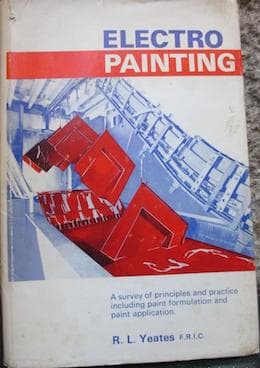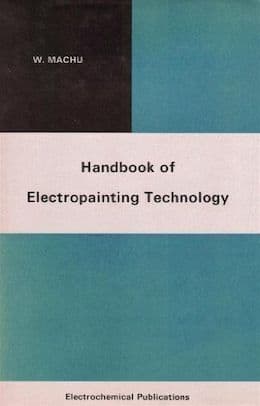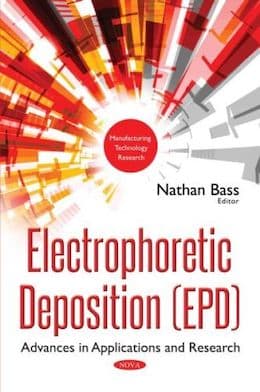
-----
MEQ vs pH in CED bath. Paint conductivity is dropping/rising
Q. Kindly suggest with maintaining pH-7 & conductivity-less than 10; if possible suggest some ideas.
We have recently changed the resin of the mixed bed, but are not able to get a stable pH & conductivity during the CED process.
- Lukhnow UP, India
July 30, 2023
⇩ Related postings, oldest first ⇩
by Electrocoat Association

on eBay or Amazon
or AbeBooks
(affil link)
Q. What is the relation between MEQ (milliequivalents) level & pH of the CED BATH.
Please offer the equation relating these two parameters.
Sir, I am getting higher DFT with even a degree rise in bath temperature, Why?
Conductivity 880 siemens
Bath parameter pH 5.35
Voltage 150V
Temperature 26 & DFT 28 - 33 Mic
Temperature 28 & DFT 32 - 40
paint shop - Chennai, Tamilnadu, India
2006
A. Actually, quite a feat. Normally, one would expect a coating of 15 micron ± 2 micron.
As for the relationship with temperature, the thumb rule is one degree is equal to one micron. But do not read this thumb rule in isolation. Coating thickness is also related to NVM, pH and conductivity besides other factors.
But before we try and answer that please post more details of what is being coated, how much coating time, and supplier of E-coat paint.
Mohali, Punjab, India
A. Coating thickness can vary if the area of components will vary and we put same voltage -- so area should also be seen to control DFT.
R B Singh- Faridabad, Haryana, India
July 24, 2015
Multiple threads merged: please forgive chronology errors and repetition 🙂
Q. If conductivity of CED bath is reduced up to 400 microsiemens and pH is 6.2 , then what happens in the coating? Then how can I increase conductivity?
My CED bath level is reduced daily after some processing of articles. How can we maintain bath level? (NVM % is within the limit)
Rexnord - Mumbai, India
2006
A. At a pH of 6.2 you should have a paint kick-out!
Simply add the pH controller supplied by the paint supplier and your pH will fall within range and the conductivity will go up.
Your paint supplier should be able to help you on that.
Mohali, Punjab, India
![]() Thank you Mr. Gurvin, but my pH is within the limit.
Thank you Mr. Gurvin, but my pH is within the limit.
Rexnord - Mumbai, India
? What is the your resin character?
Dr Halim Polat- Istanbul, Turkey
by Bruggemann & Rach

on eBay or Amazon
or AbeBooks
(affil link)
Q. Hi everybody.
I've experienced almost the same issue lately!
Although all CED bath parameters have been in the range as below, the conductivity of CED paint gradually decreased from 1600 to around 1000 value.
NV: 15%
pH: 6
MEQ: 38
Moreover, we couldn't find any UF drainage or bacteria attack!
Your response would be highly appreciated :)
- Tehran, Iran
November 25, 2016
A. Your MEQ & pH value are not in proportion. Please check again.
Avnash Vidhate- Nashik, India
Q. My name is Thomas and I've been having problems with high conductivity in my PPG paint bath can you please tell me what I must do to get a lower conductivity level?
Thomas Hudson- Anderson, Indiana
November 15, 2019
A. Send some ultrafilter permeate to drain and make up the volume with water. This may take several days to get back into range. Most importantly - find the source of the high conductivity. (i.e. drag in from pretreatment.)
Dan Mack- Horicon, Wisconsin
? What is the pH of your paint in the tank ?
Avinash Vidhate- Nashik, Mahatashtra, India
by Reginald Leslie Yeates

on Amazon
or AbeBooks
(affil link)
Q. My CED bath conductivity is decreasing daily. How can I increase conductivity of CED Bath? Please give me a suggestion about this.
Archana Dhapse- Pune, India
October 1, 2020
? What is your CED bath pH value ?

Baljeet Singh
- Ludhiana Punjab, India
Q. pH value of CED Bath is 5.46
Archana Dhapse [returning]- Pune Maharatra
November 12, 2020
Q. CED bath conductivity is low ... how to increase?
Sagar Patel- Rajkot gujrat
June 7, 2021
A. Good day, Sagar Patel!
First, follow the parameters and limits of the E-paint supplier.
To increase the conductivity of the E-paint in the bath:
1. increase the resin and paste content, solid and p/b ratio go up.
2. check the pH of E-paint, decreasing the pH increases the conductivity.
3. check the solvent content, increasing the solvent increases the conductivity.
What changes in the quality of the coating do you observe at low conductivity?
- Minsk Belarus
Q. How to perform Acid MEQ of CED Bath manually?
- Lahore Pakistan
November 3, 2022
MATERIALS AND APPRARATUS:
1. Analytical balance (capable of weighing to an accuracy 0.01 g)
2. Magnetic stirrer with magnet.
3. pH meter with stand.
4. Burette 25 ml with stand.
5. Potassium Hydroxide (standard volumetric solution (KOH) = 0.1N in Deionized water).
6. THF (Tetrahydrofuran)
7. Butyl Cellosolve for electrode cleaning.
PROCEDURE:
1- Clean the electrode of pH meter with butyl cellosolve and rinse with Deionized water and calibrate the pH meter with pH standard solution (buffer 4.0 and buffer 7.0).
2- Record the weight of empty beaker (W1).
3- Add sample into the beaker and record the weight (W2).
(quantity of the sample is mentioned in the table below)
4- Add approximately 60 ml of THF (tetrahydrofuran) reagent.
5- Place the beaker on magnetic stirrer.
6- Dip the electrode of pH meter in above sample solution.
7- Titrate it with 0.1 N KOH standard solution until the pH achieved 10.
8- Record the volume (ml) of 0.1N KOH consumed for titration (T1).
CALCULATION:
MEQ Value = T1 x Normality of KOH X 100/(W2-W1) x NVM%/100
- Lahore Pakistan
October 7, 2023
![]() Thanks Sir
Thanks Sir
- Lahore Pakistan
⇦ Tip: Readers want to learn from your situation;
so some readers skip abstract questions.
Q. What is the qty. of sample taken for testing?
Kailash Chand- Faridabad, India
July 4, 2024
Q, A, or Comment on THIS thread -or- Start a NEW Thread


